Climate Change and Respiratory Health in the Built Environment
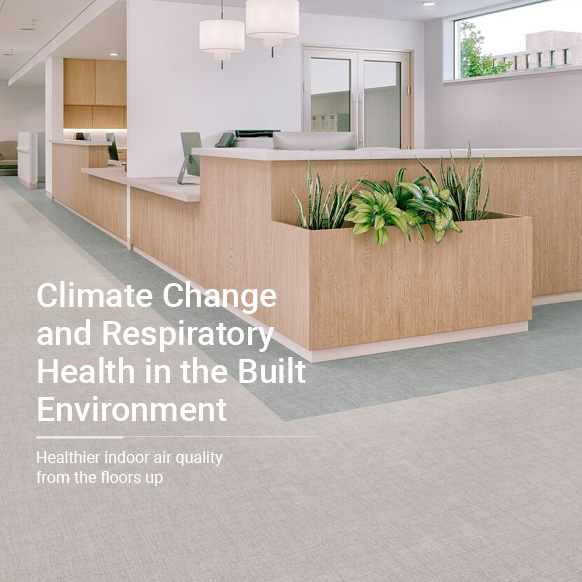
For years, scientists and researchers have warned us of the effects of climate change on our outdoor environments and ecosystems. But what are the more personal health effects of climate change, and how are extreme weather events also impacting our indoor environments? In this whitepaper, we’ll show how these events are affecting air quality—both indoors and out—and exacerbating chronic respiratory conditions like asthma and severe allergies.

Table of contents
COVER: iD Latitude Wood Ash 3308
Introduction
For years, scientists and researchers have warned us of the effects of climate change on our outdoor environments and ecosystems. The observable effects of climate change include biodiversity loss; sea level rise from the melting of polar ice caps; and extreme weather events like heatwaves, droughts, thunderstorms, floods, and hurricanes, among many others.
But what are the more personal health effects of climate change, and how are these extreme weather events also impacting our indoor environments?
It’ no exaggeration to say that if the effects of climate change continue to go unchecked, it will lead to poor human health outcomes. In the following pages, we’ll show how these events are affecting air quality—both indoors and out—and exacerbating chronic respiratory conditions like asthma and severe allergies. This whitepaper addresses where we are today and what Tarkett is doing to help you support better air quality within the built environments you manage.
First, let’s define climate change
This term refers to long-term shifts in temperatures and weather patterns. In other words, climate change is a change in the average conditions, like temperature and rainfall, in a region over a long period of time. These changes can be natural, like the result of heat from the sun or recurring patterns in sea surface temperature and air pressure (you might have heard the terms El Niño and La Niña that describe such phenomena, for example).
However, there is near-unanimous scientific consensus that climate change is accelerated by human activities. Anthropogenic, or human-driven, climate change is predominantly the result of resource over-extraction and the continuous use of fossil fuels (“Does Climate Change Impact Allergic Disease?”)—for example, via deforestation and natural gas fracking.
These activities are increasing the atmospheric concentrations of greenhouse gases like carbon dioxide, methane and nitrous oxide that contribute to warming and impact the air we breathe.
It’s no exaggeration to say that if the effects of climate change continue to go unchecked, it will lead to poor human health outcomes. Chronic respiratory illness is just one of many potential consequences.
Tarkett’s Climate Roadmap 2030 is a science-backed commitment to near-term emissions reduction targets, validated by the Science Based Targets initiative (SBTi) and fully aligned with the Paris Climate Agreement objective to limit global warming. By 2030, Tarkett commits to reduce by 50% absolute scope 1 and 2 greenhouse gas (GHG) emissions from a 2019 base year. Tarkett also commits to reduce by 27.5% absolute scope 3 GHG emissions from purchased goods and services and end-of-life treatment of sold products within the same timeframe. Overall, Tarkett’s climate roadmap aims at achieving by 2030 a 30% reduction in greenhouse gas emissions across its entire value chain, including the scope 3 emissions representing 90% of Tarkett’s overall GHG emissions. Read more in our Climate Roadmap 2030.
Climate change and weather events
The stakes are higher now than ever. You have likely seen the news of extreme weather events like hurricanes, tornadoes and wildfires. The increasing incidence of these events in recent years is influenced both by increasing average sea temperatures and average global surface temperature. Scientists say that Earth’s temperature has risen by an average of 0.14° Fahrenheit per decade since 1880, or about 2° F in total (Lindsey, Rebecca, and LuAnn Dahlman).
Consider Hurricane Dorian in September 2019, which hit the Eastern U.S. and parts of the Caribbean and was the worst natural disaster in the history of the Bahamas. Or the abnormal snowstorms that hit the unprepared states of Texas and Oklahoma in February 2021. During the intensifying wildfire seasons in California, the biggest state economy in the U.S., thousands of acres of forest are lost each year.
Climate change doesn’t recognize national borders, either—as you recall wildfire smoke from eastern Canada turning the New York City skyline a surreal, foggy orange in June 2023. According to news reports, “Air quality alerts reached more than a dozen American states from Montana to Vermont, with some smoke reaching as far south as Alabama” (Wolfe, Sutton).
The cost of climate change
Before we discuss the health implications of these extreme weather events, it’s important to note their financial implications. In 2022 alone, the U.S. experienced 18 separate
weather and climate disasters that cost at least $1 billion each. Taken together, all such catastrophic events amounted to a total price tag of at least $165 billion (Smith, Adam B.).
Also, 2022 was the sixth-warmest year on record in the period between 1880-2022 (Lindsey, Rebecca, and LuAnn Dahlman). Rick Spinrad, head of NOAA, has said, “Buckle up. More extreme events are expected” (Borenstein, Seth).
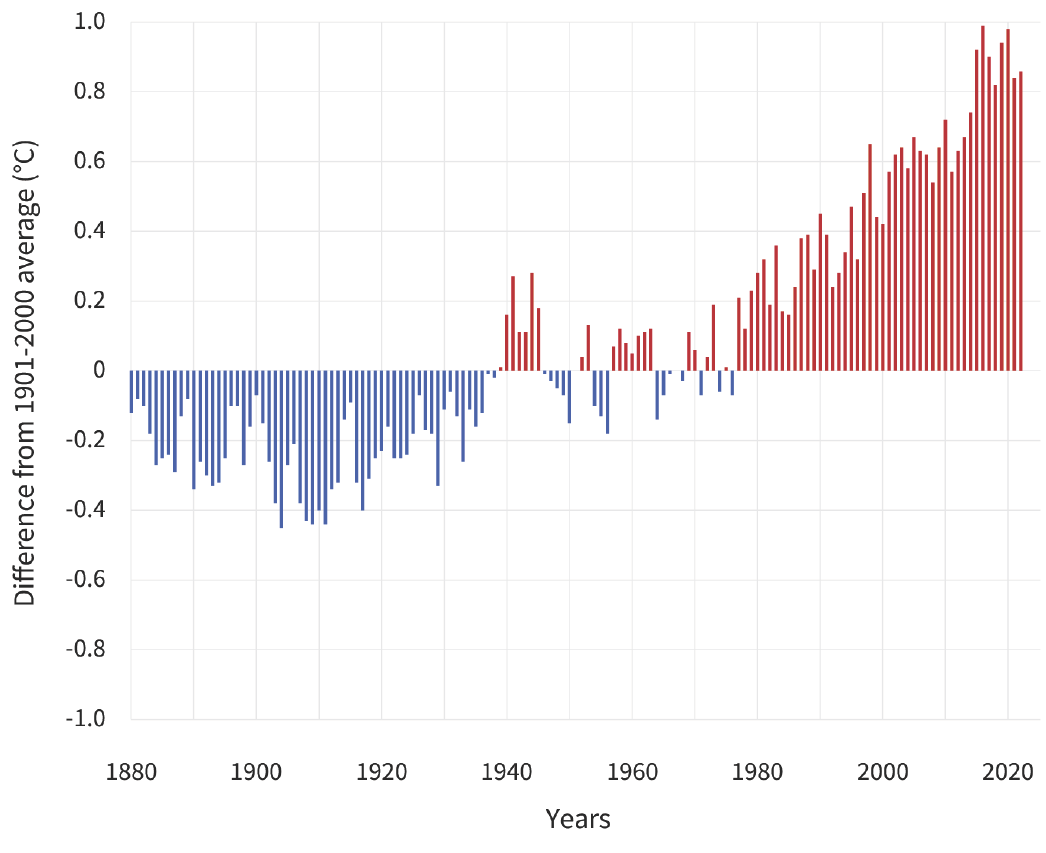
Yearly surface temperature compared to the 20th-century average from 1880 to 2022. Blue bars indicate cooler-than-average years; red bars show warmer-than-average years. NOAA Climate.gov graph, based on data from the National Centers for Environmental Information (NCEI).
Source: Climate.gov
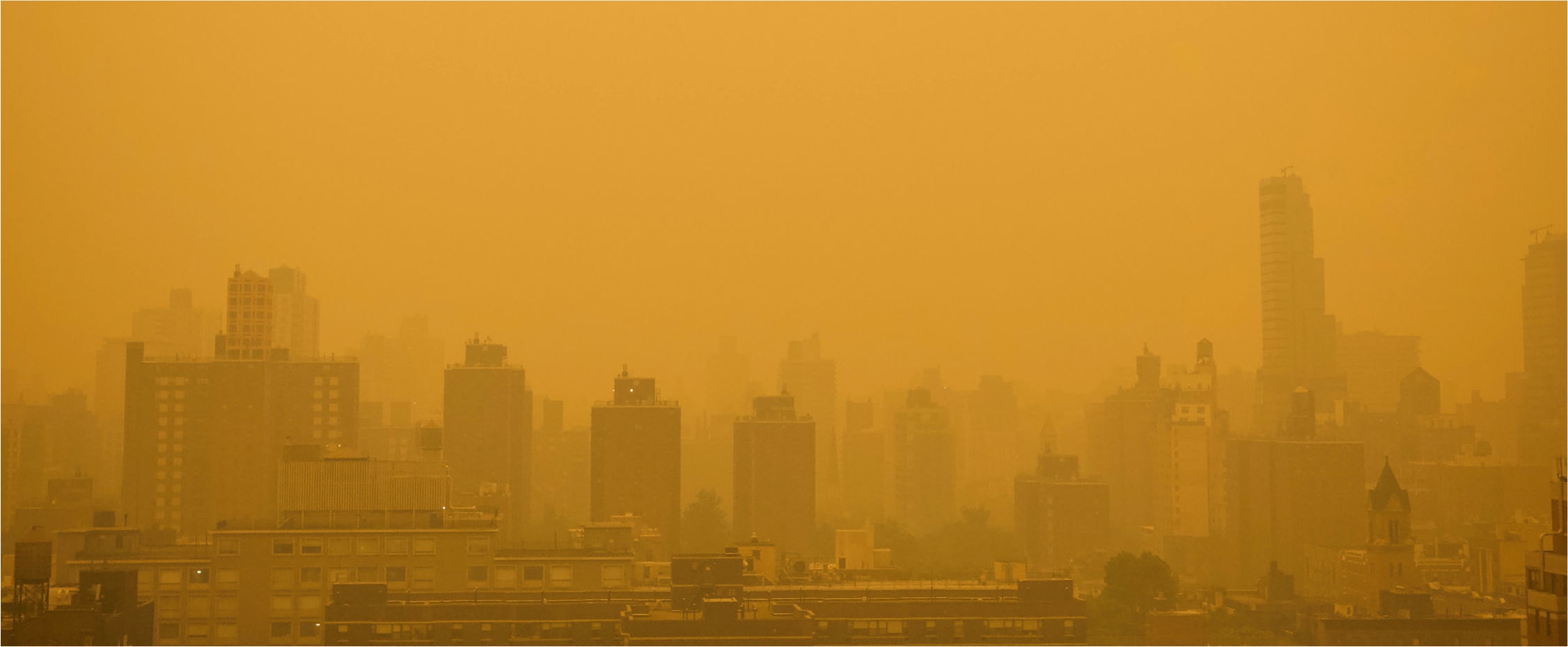
U.S. 2022 billion-dollar weather & climate disasters
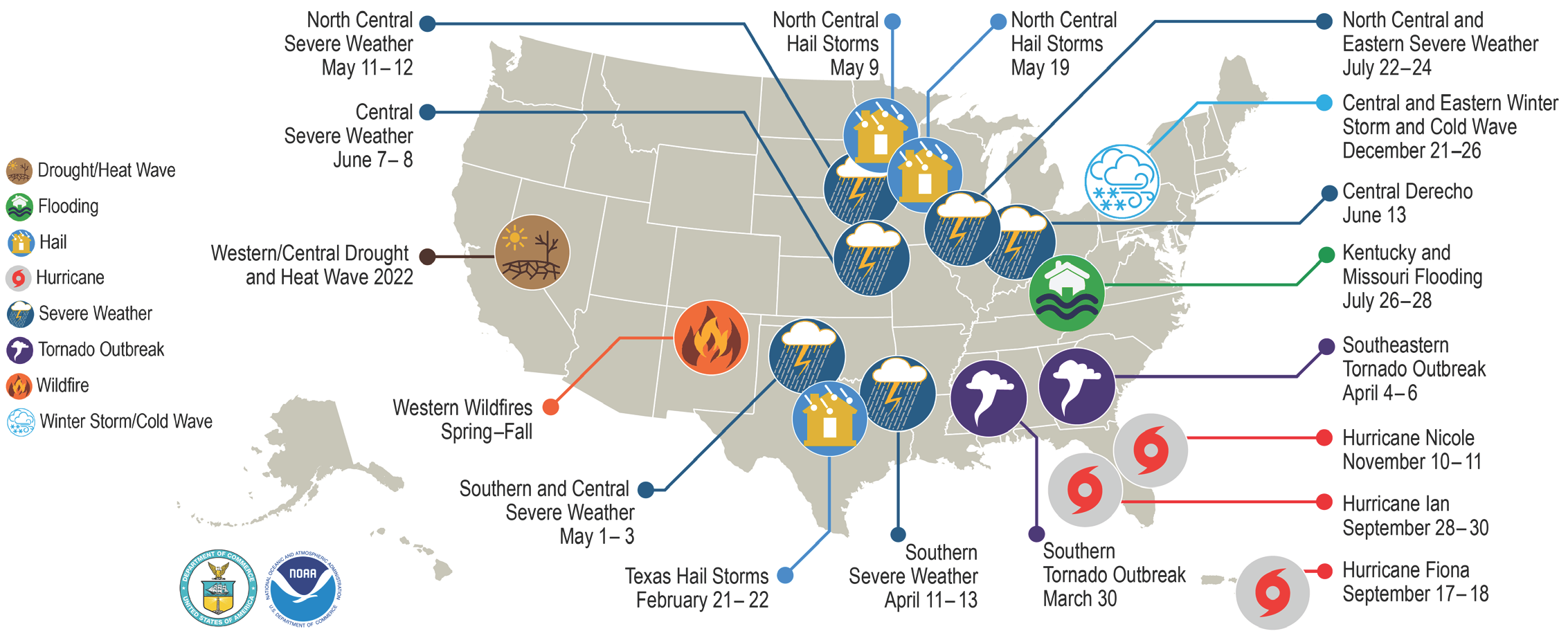
In 2022, the United States experienced 18 separate weather or climate disasters that each resulted in at least $1 billion in damages. NOAA map by NCEI Source: Climate.gov
Health impacts: How climate change impacts air quality
Currently, carbon dioxide levels are higher than at any other point in human history (Lindsey, Rebecca). You don’t have to be an environmental scientist to know that has negative consequences on the air we breathe. In addition to increased levels of greenhouse gases, here are a few of the ways the warming climate is impacting respiratory health.
Longer allergy seasons
Plants use carbon dioxide to create the oxygen we breathe, and higher atmospheric carbon dioxide levels go beyond what plants alone can handle. Warmer temperatures cause longer growing seasons during which plants, like ragweed, grasses, and trees with high allergenic potential produce more pollen, worsening allergy and asthma symptoms (“Climate Change & Health Report”). Pollen season is now 20 days longer on average compared to 1990, and pollen counts are increasing, too (Bernstein 2021a).
Higher rates of mold exposure
Climate change causes more frequent flooding and severe storms, which can lead to damp buildings and the growth of mold (“Does Climate Change Impact Allergic Disease?”). Thunderstorms can also stir up pollen and dust that trigger respiratory symptoms.
More skin contact allergies
Ragweed pollen counts rise with increasing carbon dioxide
Warmer temperatures may result in larger amounts of poison ivy, poison oak and poison sumac, the most common skin contact allergy triggers. In 2018, over 9 million American children experienced skin allergies, including reactions caused by these plants. (“Allergy Facts”).
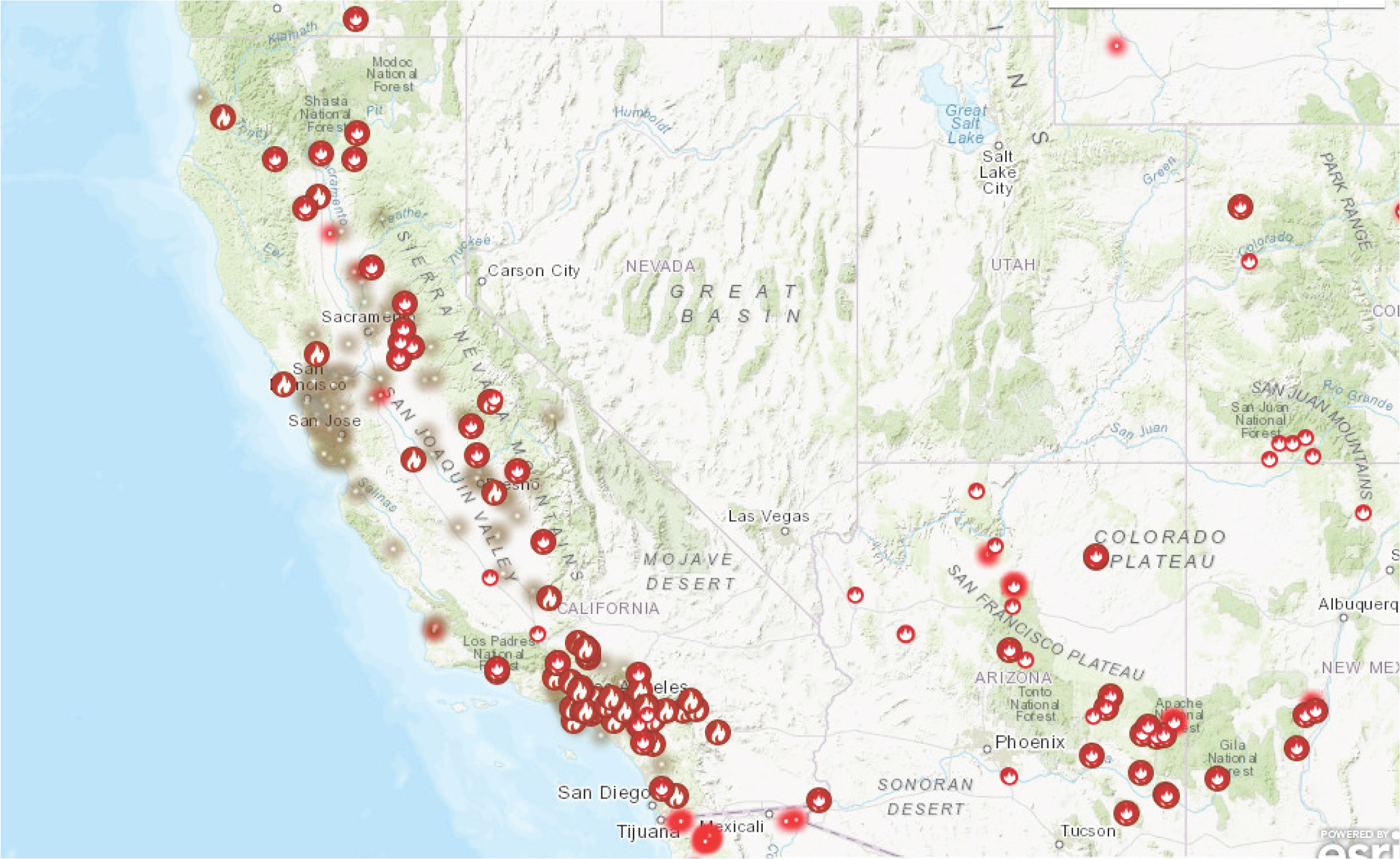
Source: Frontline Wildfire Defense. Screenshot taken June 28, 2023. Red circles with a flame inside signify real incidents while red circles with a small white dot signify thermal hotspots.
Higher levels of outdoor air pollution from fossil fuels
Cars and trucks, as well as manufacturing plants, use fossil fuels like oil and coal to operate, but the burning of fossil fuels creates particulate matter that infiltrates our lungs and exacerbates respiratory symptoms (Bernstein 2021b). Reporting from Mother Jones has also found that discriminatory policies lead to higher air pollution from diesel fumes in lower-income areas, for example (Averett, Nancy).
Higher levels of ozone pollution
Ozone is a greenhouse gas that protects our atmosphere, but it’s also a powerful lung irritant. Warmer temperatures promote ground-level ozone pollution that can trigger asthma attacks (Bernstein 2021b).
More wildfires
Hotter temperatures and drought caused by climate change are contributing to longer wildfire seasons with more frequent and intense wildfires. The resulting smoke contains particulate matter that is more toxic to children’s lungs than other sources
of air pollution. For example, wildfires caused a tenfold increase in emergency health care visits for children in San Diego between 2011-2017 (Hutchinson, Justine A, et al.). When wildfires happen in western states like California, the smoke can travel and impact North Americans across state and national borders.
Indoor air pollution
While these changes in air quality most directly impact the outdoor air, the consequences of climate change are affecting our indoor environments as well. Indoor air quality is influenced by outdoor air quality as allergens like ozone, wildfire smoke, and pollen can also leak into buildings and increase the risk of
The U.S. Environmental Protection
Agency (EPA), American Lung
Association, and WHO all view indoor air pollution as one of the greatest threats to human health.
respiratory and other illnesses (“Control Indoor Allergens”).
According to the EPA, outdoor air can flow in and out of a building in three ways (“The Inside Story: A Guide to Indoor Air Quality”):
- Natural ventilation, like using fans and opening doors and windows
- Mechanical ventilation, like the use of ventilation, air filtration, heating and cooling systems
- Infiltration
Ventilation is an important method for reducing airborne allergens. However, outdoor air can “infiltrate” indoor spaces through openings, joints and cracks in the walls, floors and ceilings, as well as cracks around windows and doors. It can also enter buildings as your employees and visitors enter and exit.
Common sources of indoor air pollution include:
- Chemical cleaners and air-freshening sprays
- Central heating and cooling systems with poor filtration
- Humidity that encourages mold and mold spores
- Dust mites
- Asbestos-containing insulation
- Paints, adhesives, and solvents
- Interior finishes and furniture that contain high levels of volatile organic compounds (VOCs), from the chemicals used in their manufacturing
- Outdoor air pollution, like from ozone, pollen, diesel fumes, and smoke, that leaks indoors
Source: “The Inside Story: A Guide to Indoor Air Quality” (EPA)
The health consequences that can result from indoor air pollution are not limited by time (“The Inside Story: A Guide to Indoor Air Quality”). They can show up immediately or after years of short-term or long-term exposure.
How air quality influences allergies and asthma
Americans spend more time indoors than ever. Roughly 90% of our time takes place in built environments: at home, at work or school, and pursuing hobbies and entertainment (“The Inside Story: A Guide to Indoor Air Quality”).
EPA studies have also shown indoor air is typically two to five times more toxic than outdoor air, with indoor air pollutants occasionally found in concentrations up to 100 times higher than outdoor levels (“Why Indoor Air Quality Is Important to Schools”).
Allergies, which affect 1 in 7 Americans, are one of the most common chronic diseases. They also constitute the sixth leading cause of chronic illness in the U.S. (“The Inside Story: A Guide to Indoor Air Quality,” EPA; “Allergy Facts,” AAFA). The most common respiratory allergy triggers include tree, grass and weed pollen; mold spores; dust mites; and pet dander.
AAFA describes asthma as “a chronic lung disease that causes airways to become inflamed, making it hard to breathe” (“My Life With Asthma”). Asthma attacks, which can be brought on or worsened by allergies, involve symptoms like coughing, shortness of breath, wheezing and chest tightness (“Reduce Asthma Attacks – RD-04”).
While some Americans struggle with seasonal allergies, breathing issues are a year-round reality for many others. In 2020, the New York Times reported on a particularly bad year for California wildfires, which have been worsened by climate change (Sengupta, Somini). In the Wells family, one of the families interviewed, both Wells children, Katie and Ryan, have asthma. They are two of the 25 million Americans (about 1 in 13) living with asthma, according to AAFA.
The Wells’ asthma attacks are exacerbated by regular wildfires, a not-so-unusual phenomenon in the suburb of Fresno, California where they live. In 2022, Fresno ranked fifth in a list of the top 100 most challenging places to live with asthma (Asthma Capitals™).
While the family wants to move to a place with better air quality, in 2020, they had put it off for economic reasons.
Asthma and allergies in the workplace
The pandemic helped highlight the importance of indoor air quality in the workplace and challenged employers to make stronger commitments toward protecting the well-being of people and the planet. Research from 2022 found that 60% of respondents are at least moderately concerned about indoor air quality, and 37% are more concerned about indoor air quality now versus before the pandemic (“What Is Home?” Report).
Chronic respiratory illness is a top reason why Americans miss work, which can lead to financial gaps for people with asthma and their families, as well as gaps in productivity for our employers and communities (“Asthma in Adults”).
In addition to asthma’s social and economic costs, this chronic condition is associated with high health care costs, including visits to the emergency room, hospitalizations, and medications. According to the Centers for Disease Control and Prevention (CDC), a healthier workforce can mean lower direct costs, including insurance premiums, as well as lower indirect costs from sick days and depressed productivity (“Workplace Health Promotion”).
Poor indoor air quality doesn’t just impact the productivity of people with asthma and allergies. For example, a 2015 Harvard study found that occupants in buildings with low VOC levels scored 61% higher on a critical thinking skills test than occupants in buildings with typical VOC levels (“The Impact of Green Buildings on Cognitive Function”). This score increased to 101% higher in buildings with increased ventilation rates.
Another Harvard study from 2021 found that low air quality in offices can significantly impact employees’ focus, response times and productivity (Sweeney, Chris).
Building indoor spaces that support good indoor air quality
In general, full-time U.S. employees spend more than one-third of their day, five days a week, working. We believe everyone deserves to breathe easy and feel safe in the spaces where they spend the most time.
When we commit to improving indoor air quality in spaces where we act as decision makers, we can influence better health outcomes for our coworkers, students, visitors and friends living with asthma and allergies.
What can we do?
When it comes to building and finishing materials, our selections should be guided by a few key principles.
- Choose easy-to-clean surfaces. The most common respiratory allergy triggers include tree, grass and weed pollen; mold spores; dust mites; and pet dander, which are spread through indoor and outdoor air and can settle onto furniture and floors in our built environments. We can bring pollen and pet dander into our workplaces from our homes or the outdoors, which is why easy-to-clean surfaces can make it easier for employers to manage employee health risks.
- Commit to low-VOC products and cleaning agents. Unfortunately, products with high VOCs—chemicals often used in building materials that can enter the breathing zone because they evaporate easily at room tempera-ture—can cause allergic reactions and exacerbate respiratory symptoms, including allergy-induced asthma symptoms, or trigger contact dermatitis (Whelan, Corey).
- Ensure proper ventilation throughout the building. It’s critical to protect indoor air against the undesired “infiltration” of outdoor allergens like pollen, mold spores, diesel fuels, ozone, and smoke. HVAC considerations should also include eliminating hot and cold spots throughout the building as sudden temperature changes throughout the day can aggravate asthma symptoms for some.
- Explore third-party certifications like asthma &
allergy friendly® . Products that are CERTIFIED asthma & allergy friendly® go beyond just helping people with asthma or allergies to reduce their exposure to environmental triggers. They limit exposure to toxic chemicals and contribute toward healthier indoor environments with better air quality for everyone.
What’s the asthma & allergy friendly® certification? This certification is an independent, physician-led certification that certifies a range of products that impact the indoor environment. It sets strict standards and offers consumers a guide for selecting flooring products—as well as other products like vacuums, air filters, and paints—based on their ability to minimize triggers of asthma and allergy and contribute to a healthier indoor environment.
The CERTIFIED ASTHMA & ALLERGY FRIENDLY Mark is a Registered Certification Mark of the ASTHMA AND ALLERGY FOUNDATION OF AMERICA and ALLERGY STANDARDS LTD.
Let’s build a healthier future for people and planet
Our built environments can make or break our health.
In an ideal world, good air quality should be accessible to all. As workplace changes continue apace, employers are on the front lines of ensuring that workplaces are spaces that employees feel safe, healthy and productive.
This is particularly critical as we respond to the effects of climate change, the largest macro-threat currently facing humanity. With climate anxiety on the rise, it’s clear these pressures are affecting our mental health. Yet as climate change contributes to the extreme weather events that worsen outdoor air quality, it is also impacting our physical health—and creating an increasingly dire situation for those living with chronic allergies and asthma.
When it comes to the indoor air quality of our workplaces, schools, hospitals, and commercial centers, however, we can make decisions that provide clean air to everyone who walks through our doors and on our floors.
This will also allow us to protect the most vulnerable among us, who disproportionately experience the consequences of climate change and poor air quality.

In the face of the many challenges that contribute to high rates of respiratory illness, we believe that healthy indoor air quality starts with a strong foundation.
Our goal? Support healthier communities from the ground up— one asthma & allergy friendly® certified floor at a time.
“Air Pollution.” Asthma & Allergy Foundation of America, AAFA, 17
Did you know?
Tarkett supports the long-term health of our global community through our Tarkett Cares program. In celebration of National Indoor Air Quality Month 2020, we donated 24,520 square feet of asthma & allergy friendly® certified flooring to Yachad-DC, a local nonprofit housing remediation organization, that used the flooring to help families in the Washington, D.C. area improve the quality of the air in their homes as part of their Healthy Homes Project.
The CERTIFIED ASTHMA & ALLERGY FRIENDLY Mark is a Registered Certification Mark of the ASTHMA AND ALLERGY FOUNDATION OF AMERICA and ALLERGY STANDARDS LTD.
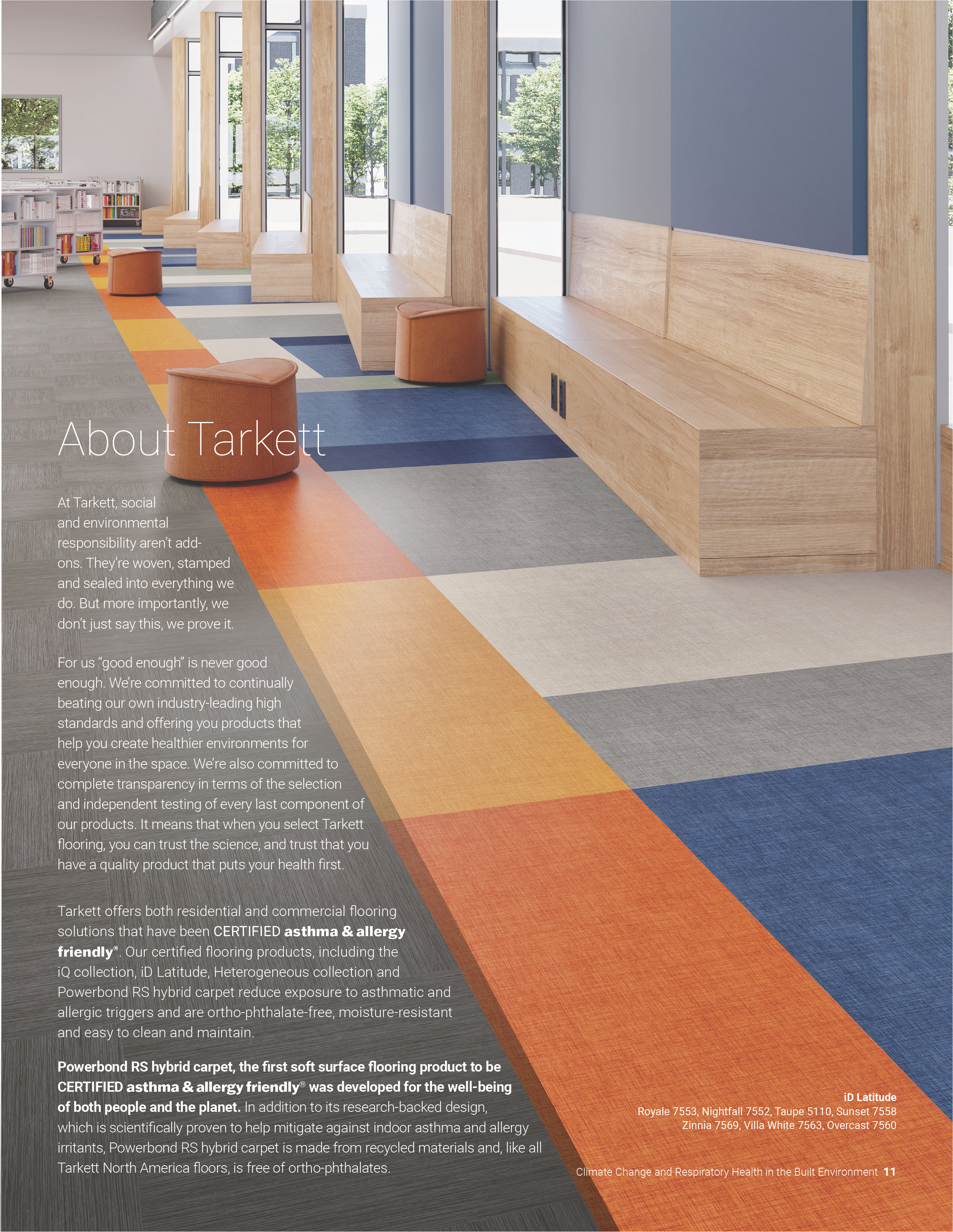
Works cited
“Air Pollution.” Asthma & Allergy Foundation of America, AAFA, 17 Jan. 2023, https://aafa.org/asthma/asthma-triggers-causes/air-pollution-smog-asthma/.
“Allergy Capitals.” Asthma & Allergy Foundation of America, AAFA, 22 Feb. 2023, https://aafa.org/asthma-allergy-research/allergy-capitals/.
“Allergy Facts.” Asthma & Allergy Foundation of America, 14 Nov. 2022, https://aafa.org/allergies/allergy-facts/.
Ambrosio, Natalie. “The Compounding Challenges of Climate Hazards and COVID-19.” PreventionWeb, United Nations Office for Disaster Risk Reduction, 22 Apr. 2020, https://www.preventionweb.net/news/ compounding-challenges-climate-hazards-and-covid-19.
“Asthma and the Workplace.” Healthtalk, DIPEX, https://healthtalk.org/ asthma/asthma-and-the-workplace.
“Asthma Capitals.” Asthma & Allergy Foundation of America, AAFA, 30 Nov. 2022, https://aafa.org/asthma-allergy-research/our-research/ asthma-capitals/.
“Asthma in Adults.” Asthma & Allergy Foundation of America, AAFA, 29 Nov. 2022, https://aafa.org/asthma/living-with-asthma/asthma-in-adults/.
“Asthma in Children.” Asthma & Allergy Foundation of America, AAFA, 19 Nov. 2022, https://aafa.org/asthma/living-with-asthma/asthma-in-children/.
Averett, Nancy. “When Air Pollution Is Overlooked, People Get Hurt— Typically People of Color.” Mother Jones, Mother Jones and the Foundation for National Progress, 19 Jan. 2022, https://www.motherjones.com/ environment/2022/01/air-pollution-overlooked-epa-rules-regulators-gaming-environmental-racism/.
Bernstein, Aaron. “Allergies.” C-CHANGE | Harvard T.H. Chan School of Public Health, Harvard T.H. Chan School of Public Health, 6 Oct. 2021, https://www.hsph.harvard.edu/c-change/subtopics/climate-change-and-allergies/.
Bernstein, Aaron. “Asthma.” C-CHANGE | Harvard T.H. Chan School of Public Health, Harvard T.H. Chan School of Public Health, 6 Oct. 2021, https://www.hsph.harvard.edu/c-change/subtopics/climate-change-and-asthma/.
Borenstein, Seth. “Why the U.S. Is Leading the World in Extreme Weather Catastrophes.” PBS, 2 Apr. 2023, www.pbs.org/newshour/science/why-the-u-s-is-leading-the-world-in-extreme-weather-catastrophes.
Borst, Ellie. “Politifact - No, 100 Corporations Do Not Produce 70% of Total Greenhouse Gas Emissions.” PolitiFact, 22 July 2022, www.politifact.com/factchecks/2022/jul/22/instagram-posts/no-100-corporations-do-not-produce-70-total-greenh/.
“Climate Change and Health.” World Health Organization, 30 Oct. 2021, www. who.int/news-room/fact-sheets/detail/climate-change-and-health.
“Climate Change & Health Report.” Asthma & Allergy Foundation of America, AAFA, 21 Nov. 2022, https://aafa.org/asthma-allergy-research/our-research/ climate-health/.
“Climate Impacts on Human Health.” City of Chicago, climatechange. chicago.gov/climate-impacts/climate-impacts-human-health. Accessed 28 June 2023.
“Climate Literacy Quiz.” Teaching Climate, 16 June 2023, cleanet.org/clean/ literacy/climate/quiz.html.
“Control Indoor Allergens.” Asthma & Allergy Foundation of America, AAFA, 30 Nov. 2022, https://aafa.org/allergies/prevent-allergies/control-indoor-allergens/.
“Does Climate Change Impact Allergic Disease?” American Academy of Allergy Asthma & Immunology, American Academy of Allergy Asthma & Immunology, 28 Sept. 2020, https://www.aaaai.org/tools-for-the-public/ conditions-library/allergies/does-climate-change-impact-allergic-disease.
“Embodied Carbon.” World Green Building Council, 28 Oct. 2022, worldgbc. org/advancing-net-zero/embodied-carbon/.
“Environmental Justice & Environmental Racism.” Greenaction.org, Greenaction for Health and Environmental Justice, https://greenaction.org/ what-is-environmental-justice/.
Euronews Green with Reuters. “Extreme Heat ‘ Disproportionately’ Impacts People with Disabilities.” Euronews, 26 June 2023, www.euronews.com/ green/2023/06/26/extreme-heat-disproportionately-impacts-people-with-disabilities-human-rights-watchdog-war.
“Live California Fire Map and Tracker.” Frontline, 21 Apr. 2023, www. frontlinewildfire.com/california-wildfire-map/.
“How Is Air Quality Measured?” NOAA SciJinks – All About Weather, NOAA, https://scijinks.gov/air-quality/.
Hutchinson, Justine A, et al. “The San Diego 2007 Wildfires and Medi-Cal Emergency Department Presentations, Inpatient Hospitalizations, and Outpatient Visits: An Observational Study of Smoke Exposure Periods and a Bidirectional Case-Crossover Analysis.” U.S. National Library of Medicine, PloS Medicine, 10 July 2018, https://www.ncbi.nlm.nih.gov/pmc/articles/ PMC6038982/.
“iD Latitude LVT Flooring.” Asthma & Allergy Friendly Certification Program, Allergy Standards Ltd, https://www.asthmaandallergyfriendly.com/USA/ certified_products/id-latitude-lvt-flooring/.
“The Impact of Green Buildings on Cognitive Function.” Sustainability at Harvard, Harvard University, 6 July 2017, https://green.harvard.edu/tools-resources/research-highlight/impact-green-buildings-cognitive-function.
“Impact Map.” Climate Impact Lab, 30 Mar. 2023, impactlab.org/map/.
“The Importance of Indoor Air Quality for Healthier Spaces.” Polyvision, Polyvision, 13 Jan. 2023, https://polyvision.com/the-importance-of-indoor-air-quality-for-healthier-spaces/.
“The Inside Story: A Guide to Indoor Air Quality.” EPA, Environmental Protection Agency, 22 Nov. 2022, https://www.epa.gov/indoor-air-quality-iaq/inside-story-guide-indoor-air-quality.
“International WELL Building Institute.” International WELL Building Institute, https://www.wellcertified.com/.
Leiserowitz, Anthony, et al. “Climate Change in the American Mind: Beliefs and Attitudes, December 2022.” Yale Program on Climate Change Communication, Yale Program on Climate Change Communication, 17 Feb. 2023, https://climatecommunication.yale.edu/publications/climate-change-in-the-american-mind-beliefs-attitudes-december-2022/.
Lindsey, Rebecca. “Climate Change: Atmospheric Carbon Dioxide.” NOAA Climate.Gov, 12 May 2023, www.climate.gov/news-features/ understanding-climate/climate-change-atmospheric-carbon-dioxide.
Lindsey, Rebecca, and LuAnn Dahlman. “Climate Change: Global Temperature.” NOAA Climate.Gov, 18, Jan. 2023, www.climate.gov/news-features/understanding-climate/climate-change-global-temperature. Accessed 28 June 2023.
“My Life With Asthma.” Asthma & Allergy Foundation of America, AAFA, 12 Nov. 2022, https://aafa.org/asthma-allergy-research/our-research/my-life-with-asthma-report/.
O’Donovan, Anna. “Certified Asthma & Allergy Friendly® IQ® Granit™ and IQ® Eminent™ Collections from Tarkett Show Dedication to Improving Indoor Air Quality.” Allergy Standards Ltd, Allergy Standards Ltd, 16 Aug. 2022, https:// www.allergystandards.com/news_events/certified-asthma-allergy-friendly-iq-granit-and-iq-eminent-collections-from-tarkett-show-dedication-to-improving-indoor-air-quality/.
O’Donovan, Anna. “Tarkett Announces That Powerbond® RS Flooring Is Certified Asthma & Allergy Friendly®.” Allergy Standards Ltd, Allergy Standards Ltd, 12 Dec. 2022, https://www.allergystandards.com/news_ events/tarkett-announces-that-powerbond-rs-flooring-is-certified-asthma-allergy-friendly/.
Pacheco, Susan E, et al. “Climate Change and Global Issues in Allergy and Immunology.” U.S. National Library of Medicine, The Journal of Allergy and Clinical Immunology, 21 Oct. 2021, https://pubmed.ncbi.nlm.nih. gov/34688774/.
“Patient Testimonial: Charmayne Anderson.” YouTube, YouTube, 20 Feb. 2018, https://www.youtube.com/watch?v=3SDYOT8eZak.
“Powerbond Hybrid Resilient.” Tarkett, Tarkett North America, https:// commercial.tarkett.com/en_US/node/powerbond-hybrid-resilient-13983.
“Reduce Asthma Deaths - RD 01.” Reduce Asthma Deaths - RD 01 - Healthy People 2030, U.S. Department of Health and Human Services, https://health. gov/healthypeople/objectives-and-data/browse-objectives/respiratory-disease/reduce-asthma-deaths-rd-01.
“Reduce Asthma Attacks - RD 04.” Reduce Asthma Attacks - RD 04 - Healthy People 2030, U.S. Department of Health and Human Services, https://health. gov/healthypeople/objectives-and-data/browse-objectives/respiratory-disease/reduce-asthma-attacks-rd-04.
“Risk for COVID-19 Infection, Hospitalization, and Death by Race/Ethnicity.” CDC.gov, Centers for Disease Control and Prevention, 28 Dec. 2022, https:// www.cdc.gov/coronavirus/2019-ncov/covid-data/investigations-discovery/ hospitalization-death-by-race-ethnicity.html.
-
Sengupta, Somini. “Wildfire Smoke Is Poisoning California’s Kids. Some Pay a Higher Price.” The New York Times, The New York Times, 27 Nov. 2020, https://www.nytimes.com/interactive/2020/11/26/climate/californiasmoke-children-health.html.
Smith, Adam B. “2022 U.S. Billion-Dollar Weather and Climate Disasters in Historical Context.” NOAA Climate.Gov, 10 Jan. 2023, www.climate.gov/ news-features/blogs/2022-us-billion-dollar-weather-and-climate-disasters-historical-context.
“Stop AJAX Asphalt!” ETMFlint.org, Environmental Transformation Movement of Flint, https://www.etmflint.org/stop-ajax-asphalt.
Sweeney, Chris. “Office Air Quality May Affect Employees’ Cognition, Productivity.” Harvard T.H. Chan School of Public Health, Harvard T.H. Chan School of Public Health, 5 Nov. 2021, https://www.hsph.harvard.edu/ news/press-releases/office-air-quality-may-affect-employees-cognition-productivity/.
What Is Home? Report. Shelton Group, an ERM Group Company, Nov. 2022, https://6711429.fs1.hubspotusercontent-na1.net/ hubfs/6711429/Reports%202022/What_Is_Home_Report_Shelton_ Group_2022.pdf.
Whelan, Corey. “Carpet Allergies: What’s Really Causing Your Symptoms?” Healthline, Healthline Media, 24 Jan. 2019, https://www.healthline.com/ health/allergies/carpet-allergies.
“Why Indoor Air Quality Is Important to Schools.” EPA, Environmental Protection Agency, 5 Dec. 2022, https://www.epa.gov/iaq-schools/why-indoor-air-quality-important-schools.
“Workplace Health Promotion.” Centers for Disease Control and Prevention, Centers for Disease Control and Prevention, 8 Mar. 2019, https://www.cdc. gov/workplacehealthpromotion/index.html.
-
Wolfe, Elizabeth and Joe Sutton. “Smoke from hundreds of Canadian wildfires blankets northern US cities with air pollution.” CNN, 25 Jul. 2023. https://www.cnn.com/2023/07/25/weather/canadian-wildfire-us-airpollution/index.html#:~:text=The%20blanket%20of%20hazy%20skies,as%20 far%20South%20as%20Alabama.
“Yale Experts Explain Climate Anxiety.” Yale Sustainability, Yale University, 13 Mar. 2023, https://sustainability.yale.edu/explainers/yale-experts-explain-climate-anxiety.
Notes
Tarkett North America
30000 Aurora Road, Solon, Ohio 44139 800.248.2878 | tarkett.com
For more accurate color and pattern representation, we suggest you visit an authorized Tarkett dealer to view an actual product sample. All third-party trademarks are the property of their respective owners.


